|
Back to Home Screen

THE TAXI DRIVER GAME
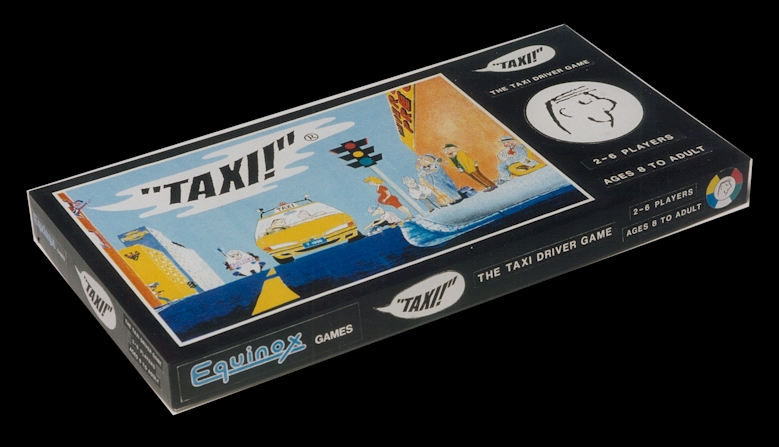
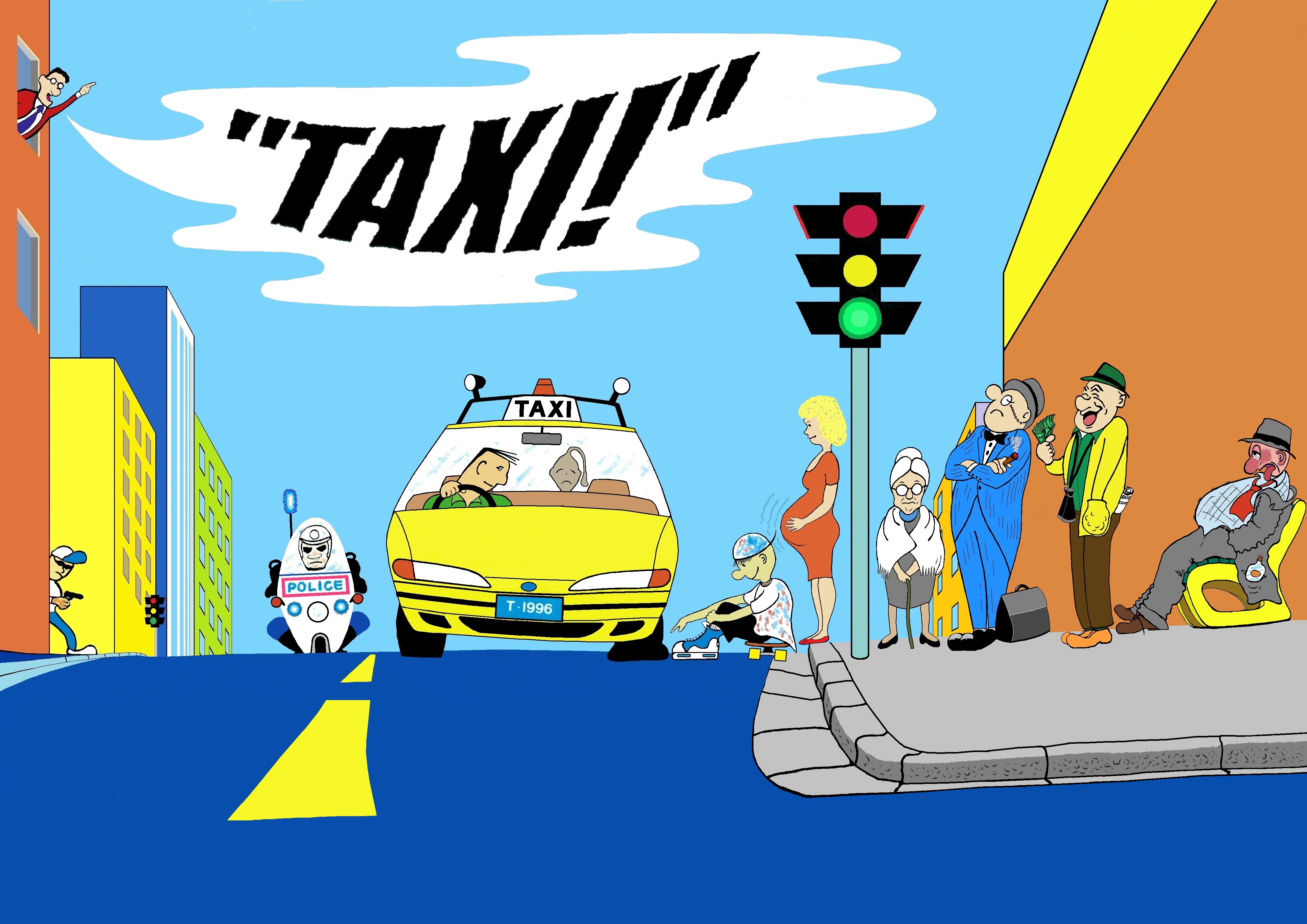
DESCRIPTION OF THE GAME:
A game of life money game in the tradition of Monopoly™
Taxi!™ is designed for two to six players.
Assuming the rolls of taxi drivers players will have the opportunity to
advance in life from hiring a taxi to owning their own taxi fleet where
good fortune combined with tactics and a shrewd gambling sense will
ultimately decide each player's success.
Just as in real life, while driving a company cab without the overheads
of ownership may be a less risky road to success, a fleet owner may
achieve great wealth or by incurring unexpected expenses go broke.
Players accumulate taxicabs (blue taxi plates)
which enable them to double, treble and quadruple their incomes.
Travelling the board players will encounter the inevitable red lights,
use the freeway, receive traffic fines, hire charges, pay overheads and
also have good fortune and fun on the way.

OBJECT OF THE GAME:
To accumulate more wealth than your taxi driver opponents.
This
objective is achieved after the fifteen (short game) or thirty (long
game) character destinations have been completed by all players still
in the game.
At this point each player adds the values of any taxi/s owned to any
moneys in his or her possession. The wealthiest player then declared
the winner.
DESCRIPTION OF PLAYING PARTS: -
1. Playing board: - The board represents a
street map with minor roads (bitumen black), major roads (bitumen black
with white center lines), a freeway (concrete grey), traffic lights
(red dots), freeway entries (white dots) and twenty nine character
destinations (one being the taxi base in the center of the board.

2.
Six destination guides: - There are six destination guides color
matched to player tokens. These indicate the direction and order of
play to each destination.

3.
Two dice (one 1 to 6 movement dice and one polyhedron 12 sided freeway/green -light/blank dice).
4.
Six color-coded (taxi's) playing tokens.
5.
Six color-coded (passenger) destination playing tokens.
6.
Thirty (green) "green light" tablets.
7.
Twelve (white) freeway entries pass tablets.
8. Fifty Passenger cards.
9. Fifty Journey cards.
10. Fifty Expense cards.
11. Six Taxi ownership cards.
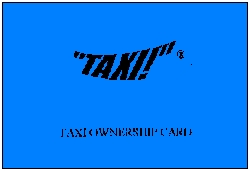 |
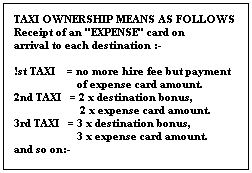 |
|
12. Twelve (yellow/black) roadwork detour barriers.
13. Thirty-six (blue) taxi plate tablets.
14. Play money representing $10, $20, $50, $100, $500, $1,000 and $5,000 notes.

15. Rule book.
USE OF PLAYING PARTS: -
Playing
Board. Representing a road map similar to a street directory. I.e. The
freeway has directional arrows indicating the direction of travel. The
two-way major and minor roads don't. The freeway entries are indicated
by white dots and traffic lights are indicated by red dots.
The small circle in the center of the board is the main character or
taxi base destination containing the six colours that represent the
players.
The twenty eight smaller squares and rectangles with different names
and character heads placed at other areas over the board are (along
with the base) the destinations players will travel to and from when
using the board. Each of these twenty- eight smaller destinations has a
small (X) marked on one of the roads/ streets bordering it. This is
where a player must finish to complete a destination.
The red traffic light dots are just that, "red". In other words all
traffic lights are to be considered red and only passable if a player
can produce a green "green light" tablet (one tablet for each red dot
"red light").
"Green light" tablets are won by dice throw.
The white freeway entry dots are also impassable and are placed as if
toll gates at the only entries to the freeway. To enter and use the
freeway a player must first produce a white "freeway" tablet. A white
freeway pass tablet is either: -
a) Won by dice throw.
b) Won by gamble. Ref:- Journey cards
NOTE: - Unlike most board games movement in TAXI!™ is not by playing
spaces or stepping squares. In "TAXI!"® (1= one street 6= six streets)
When travelling the board (moving a taxi token) The number of streets
traveled equal no more than the number indicated on the upward face of
the die. That is to say the player may move the full length of any
street, road or freeway (constituting one go) providing s/he has the
required number of "green light" or "freeway" tablets to do so. Once a
player turns a right angle, reverses or is beginning another turn it
becomes another street or number on the dice. I.e. if a player finishes
a turn unable to proceed straight ahead because of a "red" traffic
light s/he begins his/her next turn as if it is another street. Players
about to encounter a "red light" can either: -
a) Produce a "green light" and pass through it.
b) Stop and sacrifice any remaining streets on dice.
c) Avoid it by travelling around it.
A player may stop at any point on any street, road or freeway off ramp
adjacent to or in line with the next street that they wish to travel.
Players cannot block each others progress with a playing token (taxi or
passenger) If a token sits in an opposing players path s/he can move
his/her taxi token past it.
The only blocking or impeding of an opposing player is with the placement of a "roadwork detour" barrier. Ref: - Journey cards.
The roads that lead on and off the freeway can continue as part of that
freeway as if one street. E.g. If a player had finished a previous turn
on one of the roads leading on to the freeway. S/he can begin his/her
next turn and travel along the black lead on road, on to the grey
freeway (having produced a freeway tablet) and also along the black off
ramp road as far as any "green light" tablets s/he possesses allows. As
if one street.
Other than when on the freeway. Once a player turns right or left 90° s/he has begun another street.
DESTINATION GUIDES: - There are six (one per player) colored to match
each player's different colored playing token. Each one indicates with
the character faces of each destination the "different" journey each
player takes at the same time. By the time each player has arrived back
at the taxi base (being his/her fifteenth or thirtieth destination)
s/he will have attempted to travel all of the destinations as his/her
opponents.
DICE: - There are two dice. One dotted 1 to 6 with each dot to represent one street. E.g. Throw a four and travel four streets.
The second dice is a black twelve sided with two white freeway dots
five green light dots, and five blank faces. This dice is to win
freeway passes and green light tablets.
The 1 to 6 dice is thrown at the beginning of a player's turn and the freeway/green-light/blank dice after.
Any freeway or green light tablets won are used on following turns.
TOKENS: - There are six moving (Taxi) tokens of different colors and six color matched destination (Passenger) tokens.
A Taxi token is moved with each player's turn of dice throw or by card instruction.
The color matched Passenger token is placed on the character
destination that each player is about to travel and remains there until
the first player or players reach their destination.
The first player to reach his or her destination will win (or share
with any opponent/s who reach their destination on the same dice round)
the destination bonus of six thousand dollars ($6,000).
Any player/s that don't reach their destination on the winning turn,
abort their attempt and move their Taxi token directly to it as to
begin for the next destination. Everyone's passenger token is then
moved to his or her next intended destination.
GREEN TABLETS - Or "green lights" are won by dice throw and used as
needed to pass through "red lights" (one tablet per traffic light).
Once won they are kept until used. Once used the are returned to a
player previously selected to act as both banker and the minister of
transport.
WHITE TABLETS - Or "freeway" entry tablets are won by dice throw or a special Journey gamble card.
The freeway tablets are held and used when a player wishes to pass the
freeway entry tollgates or white dots on the board. Once used they are
returned to the minister of transport.
JOURNEY CARDS: - A Journey card is picked up by choice at the beginning
of a player's turn (before throwing the dice). If a player forgets s/he
forfeits the card but can still move the number of streets s/he throws
with the die.
A Journey card can bring good or bad luck. Among the Journey cards are
six cards marked "gamble card". Two of these with the word "money", two
with the word "freeway" and two with the word "taxi".
When a player picks up a gamble card s/he must (for his/her own
benefit) keep it hidden from the view of his/her opponents and offer
them the chance to gamble as to what word is on it. This is done in
three ways: -
If an opposing player wants to gamble that the word is "money" s/he
bets $1,000 dollars of his/her own "Taxi!" money. If correct s/he
collects $3,000 (from the bank) and keeps the one thousand dollars bet.
If s/he is wrong the cardholder keeps the $1,000.
If an opposing player wants to gamble that the word is "freeway" s/he
must have a "green light" tablet to do so. If s/he can does and is
correct s/he wins a "freeway" tablet and keeps his/her "green light".
If wrong the cardholder keeps the 'green light".
If an opposing player wants to gamble that the word is "taxi" s/he bets
$5,000 dollars of his/her own "Taxi!" money. If correct s/he wins a
"taxi plate" (taxi ownership) worth fifteen thousand dollars (from the
minister of transport) and keeps his/her five thousand dollars. If
wrong the cardholder keeps the five thousand dollars.
NOTE: When a player picks up a gamble card all opposing players can
gamble on it at the same time and also differently if they wish. The
cardholder cannot lose. S/he can only win or get nothing. The gambler
either wins or loses.
Three "roadwork detour" cards are included amongst the journey cards
and carry their own explanation. When a player picks up one of these
cards, the minister of transport hands out a roadwork barrier block.
The player can save the block for future use against an opposing
player. When using the detour block against another player it must be
placed on a street to be blocked before that player rolls the dice it
can only be used for that other players one turn before returning it to
the minister of transport.
Ten "traffic fine" cards and various other individual fortune cards complete the Journey card stack.
PASSENGER CARDS: - A passenger card is picked up by choice at the
beginning of a player's turn (before throwing the dice). If a player
forgets s/he forfeits the card but can still move the number of streets
s/he throws with the die.
A Passenger card can bring good or bad luck.
EXPENSE CARDS: - An Expense card is picked up once a player has become
a taxi owner. Once a becoming a cab owner the taxi hire fee ceases to
be paid but is then required to pick up an Expense card as each
destination is reached.
Expense cards have varying degrees of expenses.
TAXI OWNERSHIP CARDS: - A taxi ownership card is received once a player
(wins or buys) his/her first taxi (taxi plate). The card explains the
benefits and expenses that come with taxi ownership.
BLUE TABLETS: - The rectangular taxi plates, are received from the
minister of transport upon purchase or winning of a taxi. Each plate
represents one taxi. The value of each is $15,000.
NOTE: - Taxi plates (taxi's) can be sold off (back to the bank) for a
depreciated amount of $5,000, during the game if a player is in debt.
The value of each taxi is still $15,000 when tallies are taken at the end of the game.
ROAD DETOUR BARRIERS. These are received from the Minister of Transport upon receipt of a Journey (roadwork detour card).
Their purpose is to impede and thus delay an opponent's arrival to his/her destination.
They can be used at the beginning of an opponent's turn (only once) before being returned to the Minister of Transport.
TO PLAY: - First select a Banker to manage the surplus money and play
cards and a Minister of Transport to hand out green lights, freeway
passes, taxi ownership cards, taxi plates and roadwork detour barriers.
The banker now distributes to each player $9,340. (one $5,000 note two
$1,000 notes, three $500 notes, four $100 notes, five $50 notes, six
$20 notes and seven $10 notes.
The Journey, Passenger and Expense cards are shuffled separately and placed face down.
Order of play is then decided and the destination guides are handed out
(players 1 to 6) with the matching colored taxi and passenger tokens.
TO START: - Each player places his/her "Taxi" playing token within the taxi base (the small circle in the center of the board).
Referring to their destination guide's player's place their "Passenger"
playing tokens on their different destinations. (They can be placed on
the character box rather than the road) The small (X) indicates where a
passenger waits and a player must complete his/her destination on the
(X).
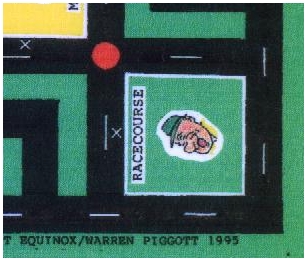
TO BEGIN: - The first player selects either a Journey or a Passenger
card. S/he then responds to the card and throws the 1 to 6 dice.
Once having moved the taxi token (throws three, moves three streets) s/he can now throw the freeway/green-light dice.
The other players follow in turn to the cards and dice until one or
more reach their first destination. The first player to arrive at his
or her destination will collect the full destination bonus of $6,000
dollars or share it equally with any other players arriving on the same
dice turn. Each player then pays a $500 taxi hire fee to the bank
(unless s/he has bought or won taxi ownership prior to arrival) Each
taxi owner picks up an Expense card and doesn't pay the hire charge.
Having collected bonuses, paid hire charges and expenses each player
then moves their Passenger token to their next destination and continue
in the same order of play as beginning previously.
The game continues as per destination guide and card instruction until
the fifteenth (base) short game or on to a further fifteen destination
trips (the thirtieth being back to base) for the long game. The base
pays a winning bonus just as any other and is reached when in the base
circle.
Once all players are back at the base taxi owners pick up their last Expense card and pay their last expense.
The final tallies are now made: - Taxi values $15,000 each plus any money held totaled and the winner declared.
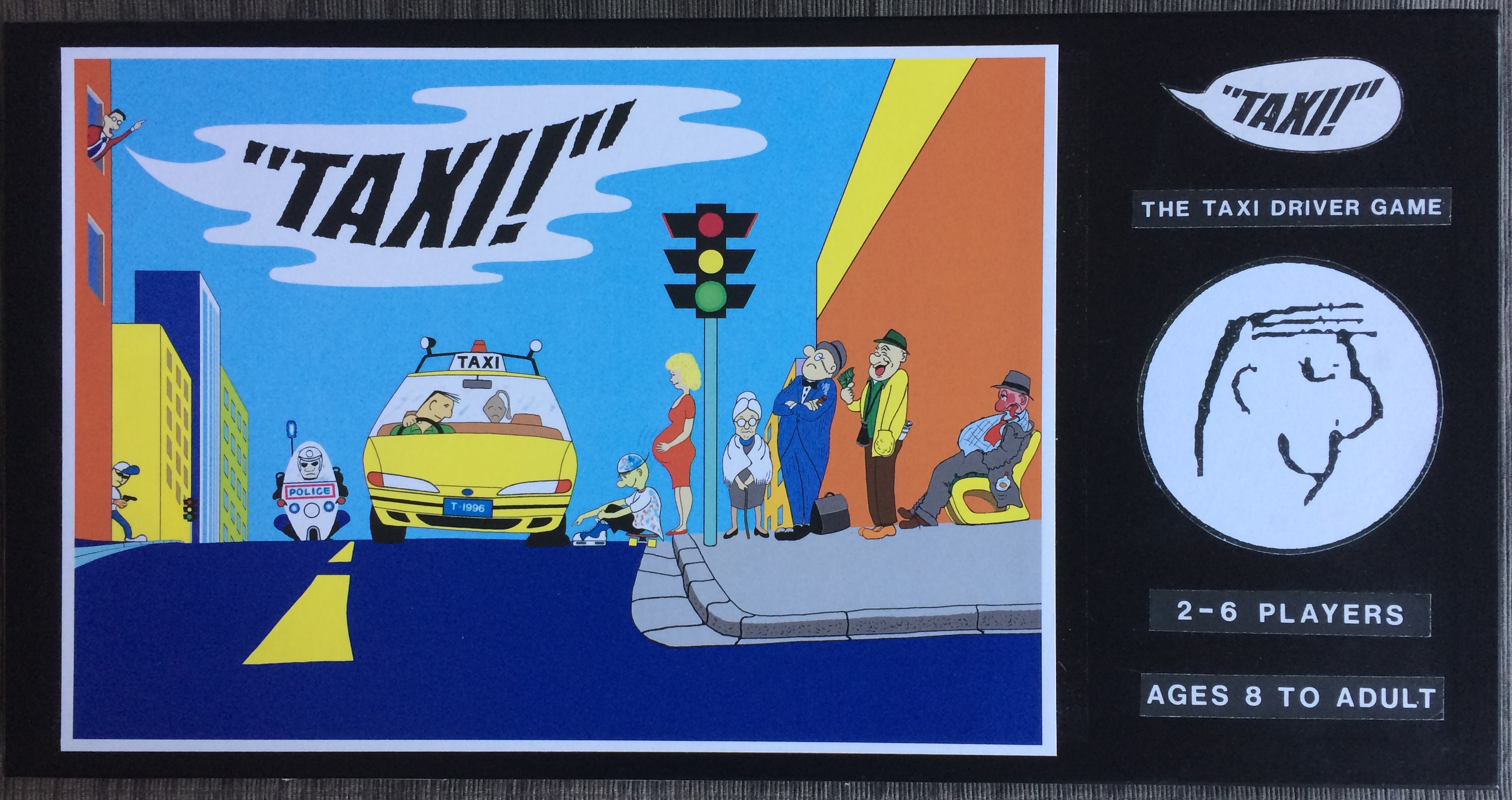


|







